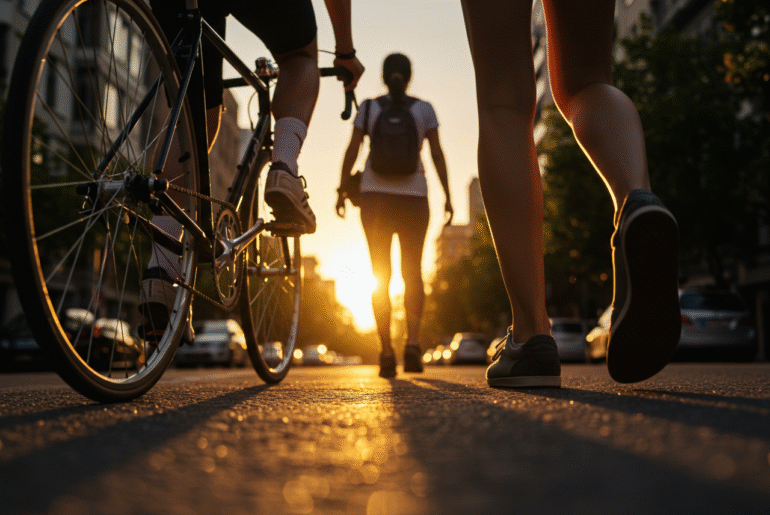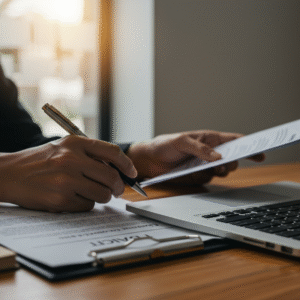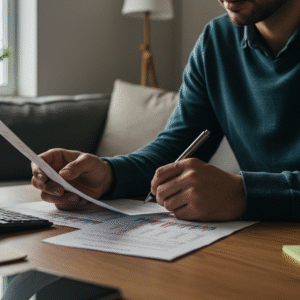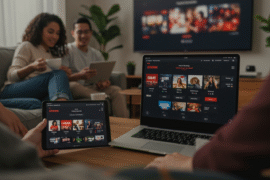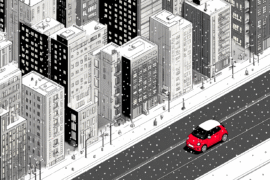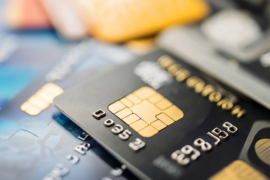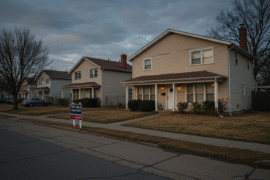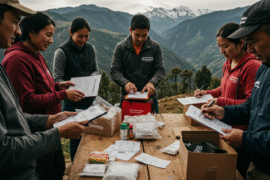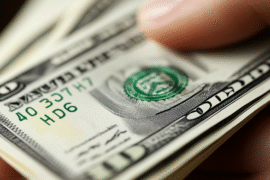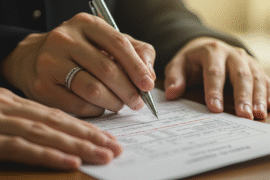This article may contain references to products or services from one or more of our advertisers or partners. We may receive compensation when you click on links to those products or services. Nonetheless, our opinions are our own.
The information presented in this article is accurate to the best of our knowledge at the time of publication. However, information is subject to change, and no guarantees are made about the continued accuracy or completeness of this content after its publication date.
- Benefits of Riding or Walking Daily
- Introduction
- Health and Wellness Advantages
- Environmental Impact and Sustainability
- Costs to Consider When Starting
- Upfront Expenses for Bikes Shoes and Gear
- Ongoing Costs for Maintenance and Replacements
- What You’ll Need to Start Commuting
- Bike Commuting Necessities
- Walking Gear Checklist
- Budget Planning for Your Daily Commute
- Final Thoughts
- Frequently Asked Questions
- Recommended Reads
Benefits of Riding or Walking Daily
- Riding a bike to work or around town lets you be free from bus times. You save money compared to using a car, and your own energy makes the bike go.
- Walking is a healthy and smart way to get around the city. You do not have to pay a lot for getting there.
- Buying the things you need, such as fenders, safety gear, and tools, will make your trip feel better.
- A good road bike and the right gear help you feel good and make your daily rides easier.
- Planning your money for riding a bike and walking means you may pay up front for things and fix them after, but over the years, you save money.
Introduction
Biking or walking as your main way to get around can improve your health, save money, and help the environment. These simple changes reduce car use, cut costs like gas and parking, and add more movement to your day. Whether you’re commuting or running errands, active transportation offers a fresh, stress-free way to connect with your surroundings. This will explore the major benefits, costs, and planning tips for a biking or walking lifestyle.
Health and Wellness Advantages
Riding a bike is good for your heart. It helps make your muscles stronger as you go more miles. Cycling is not just about working out. It is a way to keep active that helps your mind feel sharp and lifts your mood. Walking helps your body, too. It keeps your joints moving well and lowers the chance of getting long-term illnesses.
Both options let you add fitness to your daily travel in an easy way. Whether you pedal on trails or walk on city sidewalks, you’re turning your travel time into a chance to be healthy. Think about what you like to do so you can pick the way to get around that works well in your routine.
Also, these things help fight the habit of sitting too much, which happens a lot with desk jobs. Riding your bike or taking a walk can help your blood flow better. It can also make your body strong for a long time. Every mile you walk or bike helps your health, so these ways of getting around are very good for people today.
Environmental Impact and Sustainability
Bike commuting and walking are great ways to help keep our world healthy. They give off much less pollution than cars. When you choose to ride a bike or walk, you use less of the earth’s resources. This is good for people who will come after us. Think about the Pacific Northwest. Many people there ride bikes or walk on green trails. They also get to enjoy nature and help keep it safe at the same time.
These ways use little energy, so your trips give off less pollution. When you use cycling or walking, you help make the air cleaner in the city. Places like Portland and Seattle have shared paths that let people take part in these good habits.
Walking or biking to work can inspire other people too. When neighborhoods start to use eco-friendly habits, the results for the world build up over time. You help by cutting down on pollution and using less fuel. Also, you turn your trip to work into a way to care for nature.
Costs to Consider When Starting
Starting to walk or bike more will require you to spend some money at first. You also need to save for taking care of your gear later on. You might have to buy the main accessories and pay for small repairs from time to time. If you plan well, you will see that walking and biking cost less than having a car or buying tickets for buses and trains.
Start by looking at choices like secondhand bikes and gear for walking that do not cost a lot. To keep up with this kind of life, you need to spend a bit now and then on things like tires, shoes, or tools. But over time, you can save some good money. You also get to make your life better in the long run, so it is worth it.
Voted "Best Overall Budgeting App" by Forbes and WSJ
Monarch Money helps you budget, track spending, set goals, and plan your financial future—all in one app.
Get 50% OFF your first year with code MONARCHVIP
Upfront Expenses for Bikes Shoes and Gear
Getting started with a bike or walking to work means you have to buy some basic things you need. Here is a look at what you might spend at first:
| Item | What to Expect |
|---|---|
| Best Road Bikes | Entry-level options cost $500-$600; E-bikes from local bike shops range upwards. |
| Cycling Accessories | Visibility gear, fenders, and light sets start at $100 collectively. |
| Walking Gear | Comfortable walking shoes and weather-resistant clothes may cost around $150. |
When you go to a local bike shop, you should look for a bike that fits you well and has all the right parts. This makes it easy to get started and feel comfortable. It helps to pick good shoes, a backpack, and items that can handle different weather. These things make your ride easy and they feel good to use every day. When you put money into good things at the start, they last longer, and you enjoy your ride to work or school much more.
Ongoing Costs for Maintenance and Replacements
There are costs that come up over the year after you get the property. The biggest ones are for upkeep. You may also have to pay for fixes and for new items when old ones do not work. It is good to know about these costs so you can plan ahead. All people need to keep up with these things if they own a home. Over time, these regular costs add up. This means you and others need to set money aside for them. This will help you handle the work that comes up, feel less stress, and have a good home for a long time.
Getting started with an investment can make the base strong, but you need to keep spending over time to keep things working and feel good. The ongoing costs are for things like getting new tires, fixing fenders, and regular tune-ups.
Regular bike upkeep, like putting grease on the chains or fixing the brakes, comes with average costs at most local bike shops. Check your bike now and then to help your tires last longer and to stop big problems before they start. If you walk a lot, you might need to replace your shoe soles or fix walking gear from time to time.
Spending money on the care of your things can stop bigger problems in the future. The cost to keep your two wheels or feet in good shape is about $10 to $50 each month. This helps make sure they stay safe and work well in all kinds of weather.
What You’ll Need to Start Commuting
Starting this way of living needs a simple checklist. If you ride a bike to work, you need important things like fenders and gear to help people see you better. These will help your outdoor rides feel smoother. If you like walking, make sure you have shoes that can handle the weather and some support for your walks. This will help make your strolls feel easy.
Whether you want to buy the best road bikes or need useful things for walking, how you get ready will shape what kind of time you have. Let’s go over what you should have for both cycling and walking below.
Bike Commuting Necessities
Cycling every day can be a lot simpler if you have the right gear. Here are some things you should remember to get:
| Item | Purpose |
|---|---|
| Best Road Bikes | Lightweight, comfortable bikes tailored to your commute needs. |
| Fenders | Shield clothes from mud and grime on wet paths. |
| Visibility Gear | LED lights or reflective elements ensure safer road rides. |
| Backpacks or Panniers | Carry necessities securely during rides. |
Local bike shops have a lot of choices for every budget. At first, you can pick gear that costs less. Later, put your money into strong items like road bikes that help you ride smoothly. As you get better, buy things that fit you and your needs.
Walking Gear Checklist
People who like to walk need tools that are simple and work well for the best comfort. Take a look at these must-have items:
| Item | Purpose |
|---|---|
| Durable Shoes | Prioritize arch and heel support for lengthy strolls. |
| Weatherproof Accessories | Invest in jackets and umbrellas for rainy regions. |
| Minimalist Backpacks | Lightweight bags to store daily items. |
| Tracking App | Track your miles and adjust routines accordingly. |
The right gear helps you feel good when you go for long walks. You should begin with things that you can use in any season. Get the basics first, and you can add extra items as you go. Add new things when you feel you need them.
Budget Planning for Your Daily Commute
Here is a simple guide to help you plan your money when you start going to work at a new place. A change in where you go means you may have new costs, and it is good to know what to expect. Use these tips to make your first days smoother and keep control over your spending.
Moving from your old way of getting around to biking or walking takes careful planning. You need to think about how much money you have and how you spend it over time. Here is how you can look after both starting and ongoing costs.
1. Review Current Transportation Costs
Start by looking at how much money you spend now to get around. Are you paying a lot for gas, buses, or trains, or to fix your car? Knowing what you pay now helps you see how much you could save by walking or biking instead. If you trade your bus rides for walking or using a bike, you could save money. This is because you do not have to pay for things like set bus times or routes. This can give you and your family some good money back in your pocket.
2. Estimate Initial and Monthly Costs
Add up what you spend at first for your bike or walking gear. Then add the extra money you use to keep it working right.
| Category | Estimated Costs |
|---|---|
| Entry-level road bikes | $500-$600 |
| Tire replacements | Starting at $30 monthly for road tire replacements. |
| Walking gear | Waterproof shoes or jackets upwards from $150 per year. |
Keep a record of all the repair costs as they come up, especially for bike fixes like brake tweaks. It is a good idea to update your budget often, depending on the time of year, to stay on top of these costs.
3. Set Your Monthly Budget
Balance your first spending on a good road bike with what you will keep paying every month. It’s important to stay free to adjust. Plan to set aside around $40 each month. This amount should help with fixing your bike and getting small new gear now and then. Sometimes, you might face costs you did not expect. A solid plan for the budget can help you stay ready for any surprises that may come up.
Final Thoughts
Living with a bike-commuting lifestyle helps you move more easily each day and also gives you a way to live that is better for the environment. To stay safe, make sure you use the best road bikes, have the right gear, and wear things that help others see you on the road. No matter if you are riding in the Pacific Northwest or other city spaces, local bike shops give good help when you need it. Riding your bike every day is good for your health and your money, letting you have a life that is more active and better for our world.
Frequently Asked Questions
How much money do I need for bike commuting each month?
When you start bike commuting, the cost can change depending on what you need. At first, you may have to pay more to get a good bike and some gear. After buying these, you will use less money month to month. Some people spend about $20 to $50 each month on things like repairs, lights, a lock, and maybe new clothing. The cost can be higher if your ride is long or if you want extra gear. The good thing is, biking often saves you money in the end. You use less cash for gas, parking, and bus fare.
Are there affordable options for necessary gear?
Yes, there are many good and cheap choices out there if you need basic gear. You can find used bikes, helmets that do not cost a lot, and rain jackets that last long. Try to look for deals at sporting goods stores. You can also check local groups, as they sometimes offer swaps or discounts on equipment. Walking or biking can help you save money compared to driving. With the cost of gas, car repairs, and parking fees, driving often adds up to a lot. You do not have these extra costs when you go out for a walk or bike ride.
How much money do I need for bike commuting each month?
When you start bike commuting, the cost can change depending on what you need. At first, you may have to pay more to get a good bike and some gear. After buying these, you will use less money month to month. Some people spend about $20 to $50 each month on things like repairs, lights, a lock, and maybe new clothing. The cost can be higher if your ride is long or if you want extra gear. The good thing is, biking often saves you money in the end. You use less cash for gas, parking, and bus fare.
Are there affordable options for necessary gear?
Yes, There are many good and cheap choices out there if you need basic gear. You can find used bikes, helmets that do not cost a lot, and rain jackets that last long. Try to look for deals at sporting goods stores. You can also check local groups, as they sometimes offer swaps or discounts on equipment. Walking or biking can help you save money compared to driving. With the cost of gas, car repairs, and parking fees, driving often adds up to a lot. You do not have these extra costs when you go out for a walk or bike ride.
What should I consider when choosing between walking and biking?
Think about the distance you need to travel, how much time you have, and your fitness level. Biking is faster and better for longer distances. Walking is simpler and works well for short trips. Weather and road safety are important, too. Try both methods and see which fits your routine better.

Reviewed and edited by Albert Fang.
See a typo or want to suggest an edit/revision to the content? Use the contact us form to provide feedback.
At FangWallet, we value editorial integrity and open collaboration in curating quality content for readers to enjoy. Much appreciated for the assist.
Did you like our article and find it insightful? We encourage sharing the article link with family and friends to benefit as well - better yet, sharing on social media. Thank you for the support! 🍉
Article Title: Budgeting for Bike Commuting or Walking Lifestyle
https://fangwallet.com/2025/07/05/budgeting-for-bike-commuting-or-walking-lifestyle/The FangWallet Promise
FangWallet is an editorially independent resource - founded on breaking down challenging financial concepts for anyone to understand since 2014. While we adhere to editorial integrity, note that this post may contain references to products from our partners.
The FangWallet promise is always to have your best interest in mind and be transparent and honest about the financial picture.
Become an Insider

Subscribe to get a free daily budget planner printable to help get your money on track!
Make passive money the right way. No spam.
Editorial Disclaimer: The editorial content on this page is not provided by any of the companies mentioned. The opinions expressed here are the author's alone.
The content of this website is for informational purposes only and does not represent investment advice, or an offer or solicitation to buy or sell any security, investment, or product. Investors are encouraged to do their own due diligence, and, if necessary, consult professional advising before making any investment decisions. Investing involves a high degree of risk, and financial losses may occur including the potential loss of principal.
Source Citation References:
+ Inspo
There are no additional citations or references to note for this article at this time.
